Survival was never meant to be easy.
Thankfully, we have the tools available to us in today’s day and age to take some of the variables out of the process, and alleviate uncertainty.
The right tools in your hands can be immensely valuable and powerful, but if your tools fail you, there’s only so much you can do. Know-how is one thing, but starting with quality tools in an excellent survival kit is the flip side of the coin.
We’re going to go over the best survival backpack kit and the best survival medical kit, as well as some alternatives. It’s important to have one of each (for obvious reasons), and what comes in your kit absolutely matters.
If you really want to enhance your chances for survival, you’d do well to take a look at what these kits offer, and take note of how everything benefits you in numerous situations during survival.
Best Survival Kit – Reviews & Buying guide for 2022
Best Overall: Kosin Emergency Survival Kit
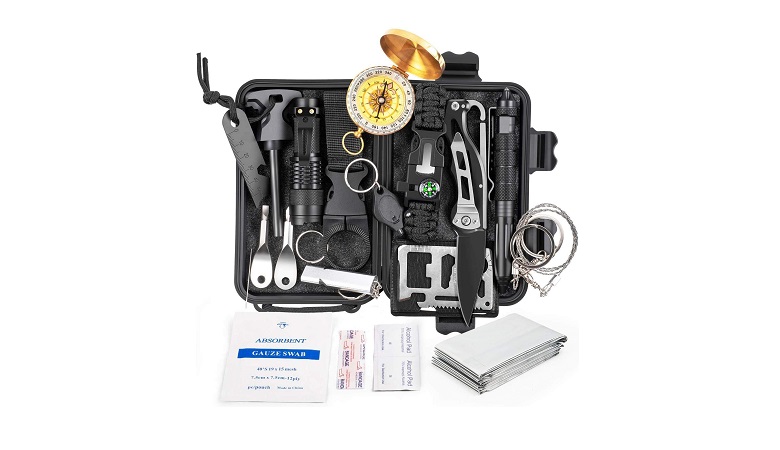
No matter how you look at it, survival kits get messy. It’s a lot of tools in a little space, and it always appears to be more cluttered than it actually is.
The good folks as Kosin really did a good job of organizing everything they possible could, and keeping it in a compact, easy to carry case. Not to put too much focus on it, but the case alone deserves a round of applause, because far too often we all end up buying a new case anyway.
As the best survival kit on the market, Kosin includes eighteen different tools for the list price. Most notably, you get a fire starter, tactical pen, whistle, tactical knife, compass, and wire saw (among other things).
The basic message that this kit gives is that you don’t have to hemorrhage your entire wallet just to get a good quality kit.
While many survivalists will source their own parts for kits and piece them together, Kosin does a good job at incorporating everything you need into one place without skimping on quality.
Built to be lightweight and consisting of durable materials, Kosin does it right. Your whistle goes up to 120 dB (which is pretty flipping loud), while your thermal blanket retains up to 90% of your body heat while in use.
I would say that the compass is passable and adds to the value, but it’s not quite as powerful as having a solid lensatic compass in your equipment list.
The paracord bracelet that they include in this kit is one that’s easily worth half the value of the entire package. I’ve seen paracord bracelets just like these sold for twenty dollars or more in the past.
You get access to a fire skyscraper, emergency rope, and an additional whistle built right in. While Kosin doesn’t mention how long the paracord survival rope is, it’s enough to offer some decent use.
- Type: Survival Kit
- Items: 18
- Weight: 1.4 lbs
Runner Up: Eiliks Survival Gear Kit
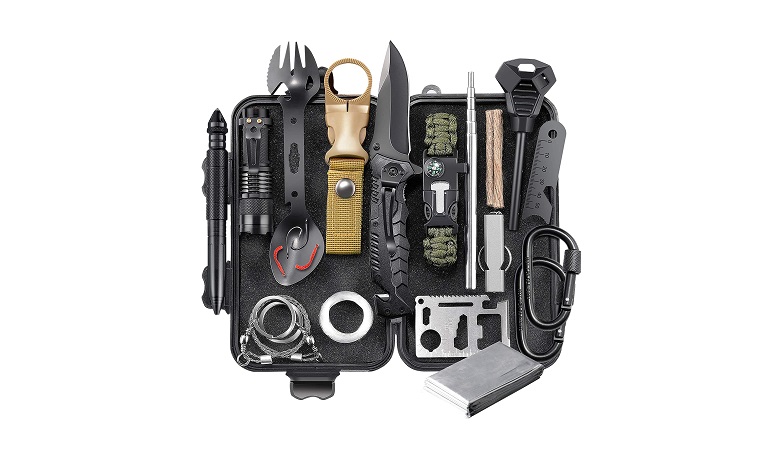
Eiliks came in at a close second. We really thought this was going to snag the top spot at first, but it came down to the wire.
As the best pocket survival kit, you get access to twenty-four different tools that all fit snugly inside of this small carrying case. The case isn’t fantastic, but the foam interior holds onto the items pretty well. The only major grievance with the case would be the plastic clasps.
Working into the actual items you get, there’s a multifunctional survival knife, whistle, utility utensil, carabiners, wire saws, a tactical flashlight, and more. Since Eiliks comes in around the same price point as Kosin, we wondered what the compromise was.
While the case is obvious, the only other major difference could be in the beige lanyard that they included. The plastic loop at the top isn’t going to hold onto much at all, and while the nylon strap is decent enough, the enormous rivet is pretty noticeable.
You have a pretty straight edge on the razor-sharp knife, so no need to hone it right out of the box.
One excellent inclusion that we don’t see in enough survival kits is this small fishing set that allows you to use something as simple as a stick to make your own fishing rod. It’s a nice inclusion, and the hook is pretty durable as well.
The utility utensil boasts a spork on one end and a fork on the other, but it also has a built-in can opener, harpoon, and wrench in the center of the handle.
Not to mention the fish scale cleaner and bottle opener attachment. With how durable that tool is alone, it could make up a quarter of this kit’s value hands down. Eiliks packed in a ton of value in this lightweight, ultra compact survival kit.
- Type: Survival Kit
- Items: 24
- Weight: 1.7 lbs
Alternative: Emdmak Outdoor Emergency Gear Kit
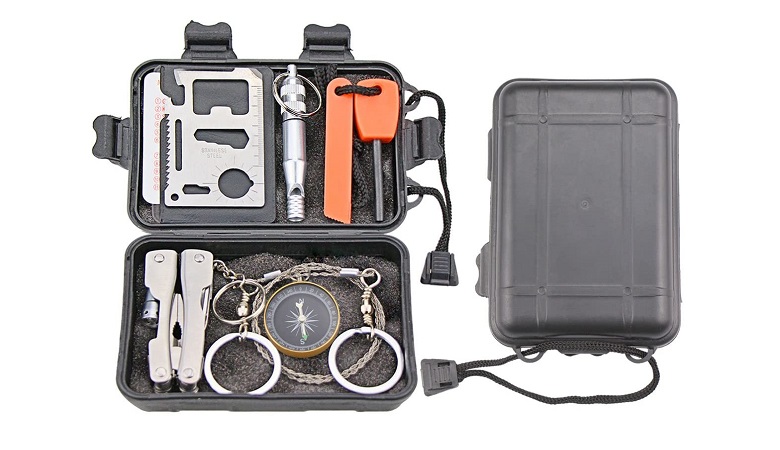
Coming up with a list for the best emergency survival kit and then keeping that list down to four can be a little bit tricky. Fortunately, Emdmak made it simple for us to choose. For the budget-friendly prepper and camper, Emdmak gives you an insane value.
Whenever you shop for something online, you look at the price, then the ratings, and make a quick assumption. We were blown away by the top-notch ratings and the rock-bottom price: it didn’t make sense – until we received the kit and got to work.
The handheld plier multitool has a ton of functionality. It includes: a bottle opener, keyring, cable scissors, flashlight, fish scaler, knife, and more.
That’s just one component of the kit, because you also have a fire starter on a lanyard, saw, compass, emergency blanket, and wallet multitool included.
Emdmak might be using the exact same case that we saw Eiliks use, which is a bit of a bummer.
It’s a low-grade plastic with bad clasps and cheap foam on the inside, but the point is that all of your tools get there in one place. You could repackage them in a bug out bag or EDC bag if you really wanted to and call it a day.
The emergency blanket included in the kit is decent, but it’s a bit small. The only other major caveat here would be the quality of the wire saw.
At first, it looks like every other wire saw you’ve seen before, but the teeth whittle down pretty quickly. Even with that being a loss, the remaining portions of the kit absolutely justify the low price.
While we found that this kit is better suited for beginners, it’s not a bad kit to use to teach your children about survival. Make sure there’s an Emdmak stored in their bug out bag, and you won’t have to worry about a thing.
- Type: Survival Kit
- Items: 8 (Multiple Uses)
- Weight: 6.8 oz
Best Survival Medical Kit: Monoki First Aid Survival Kit
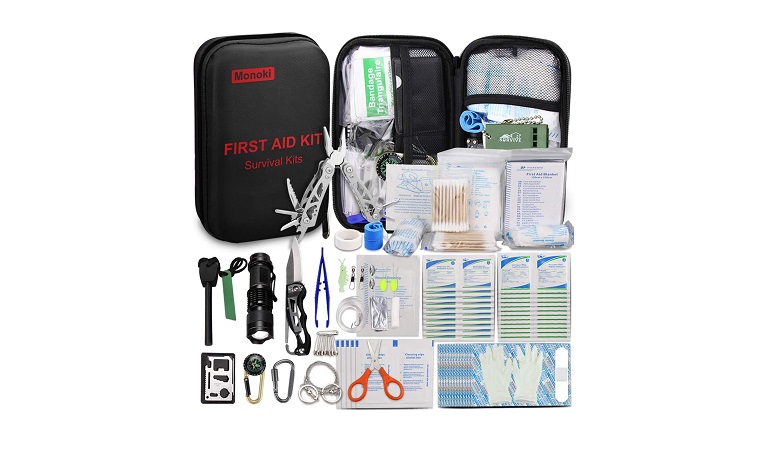
We’re winding down the list here, which is why I want to shift focus over to first aid specific survival kits. Your multitools and carabiners are only going to serve you well so long as you’re well enough to use them. You need to pack two survival kits: one utility, and one first aid.
As the best first aid kit for survival, Monoki comes with a staggering 241 pieces. To go over some of what they include, you have a multitool that can help in cutting bandages or removing splinters/debris from a wound.
There’s also a utility knife, though it isn’t full tang (hollow handle) that can see similar uses.
For sanitation, you get decent-quality PVC gloves (helpful if you have a latex allergy or aren’t sure if you do), cleansing wipes, alcohol pads, and more. Altogether, it includes just about everything you would ever need in a survival situation for light to medium-severity wounds.
So where are the downsides here?
Well, we pored over dozens of first aid kits before deciding on which ones to include on this list. First aid is something you don’t want to mess with.
The only major issues here is that the included fishing hook and line is basically bottom-tier. It’s not very useful, and it bends under such little force that it might not even last for hooking a single fish.
The case itself is good to store what comes in the kit, but it doesn’t come with a great deal of organization. When you’re cleaning a wound or helping someone with a potential infection, you want to get into that first aid kit quickly and withdraw exactly what you need.
The case doesn’t offer the best organization, but it’s durable enough to last alongside your camping, EDC, and bug out gear.
- Type: First Aid Kit
- Items: 241
- Weight: 1.55 lbs
Runner Up: Swiss Safe Professional First Aid Emergency Kit
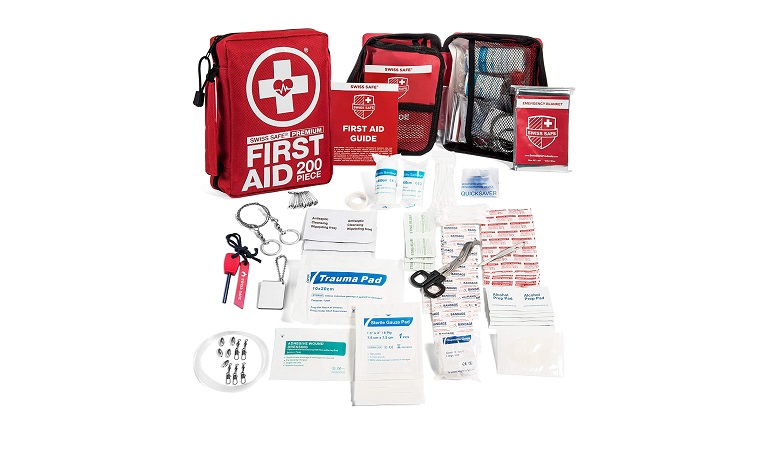
200 pieces from one of the most well-known first aid brands in the world. What could go wrong?
When we pull these reviews and inspect these products, we go in like a health inspector that wants to find one little issue to blow down the whole deck of cards. You don’t want to mess around when it comes to first aid, which is exactly what Swiss Safe had in mind when they made this.
It’s one of the best survival first aid kits out there simply because it comes with quality over quantity. There are about 20% less pieces than the previous kit we looked at, but that’s okay – what you get in this case is arguably more valuable without taking up as much room.
Inside of the first aid bag, you get organizational mesh pouches that help segregate supplies for specific issues. You could put all wound treatment in one pouch, and the inclusive multitools in another. It’s better for organization than Monoki, but not by a whole lot.
You’ll receive medical-grade scissors for cutting bandages, a wire saw, whistle, trauma pads, antiseptic wipes, bandages, an emergency blanket, and a first aid guide to teach you just what you should do with everything you have. It all comes in handy.
These are survival kits, but even brands like Swiss Safe try to include some typical survival tools in with the bag.
You have a wire saw, which doesn’t really serve too much purpose in a bag like this; an experienced survivalist is going to get one kit for utility and another for first aid. That being said, it’s still a good quality wire saw, just a bit out of place. It’s a solid kit and the medical supplies are high quality.
- Type: First Aid Kit
- Items: 200
- Weight: 12.1 oz
Best Survival Kit Buying Guide and FAQ
What to Look for in a Survival Kit
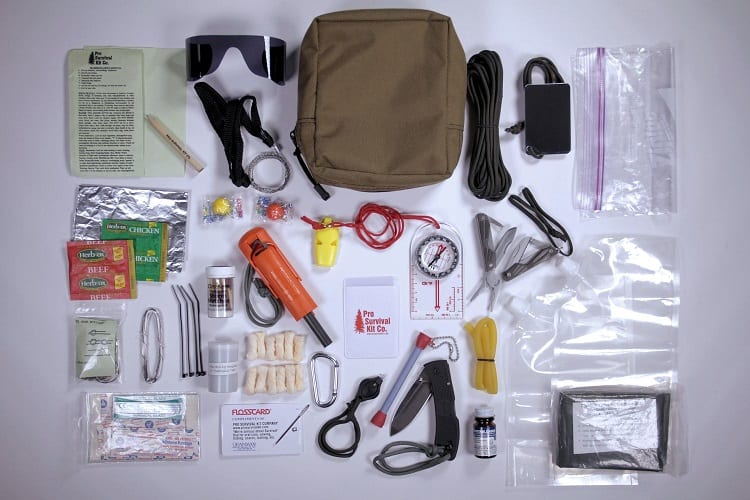
Survival kits are all about being compact, useful, and coming out in niche situations that we can apply our knowledge to.
A survival kit is an extension of your knowledge, which is why we don’t want to use sub-par kits. This is what you need to look for before you buy one.
Different Uses
How many different uses does it actually fill?
You’ll notice the Kosin kit we reviewed has eighteen different uses, most of which are survival-related and not specifically designated for first aid.
You have what you need: fire starter, knife, defense equipment, compass for navigation, and more. Find out how many uses it fills and what those uses are.
Utility vs. First Aid
Is your kit designed for utility, containing tools to help you build shelter, navigate, and defend yourself?
There are few kits that put a 50/50 focus on utility and first aid, which is why it’s recommended to get one dedicated kit for each. First aid kits can still be survival-oriented though.
Individual Tool Quality
How do the tools hold up on their own?
Break apart the value that you see by “X amount of uses for X amount of dollars,” and see what the tools can do individually. Are they durable, do they have good grips?
We had to sift through so many terrible survival kits because of the lackluster quality of each individual tool. The five we chose for this list are certainly the best out there for a reason.
Durability (Bag and Tool)
How long will the tools last, and how long will the bag that they come in last?
With shoddy construction, tools will break and the bags will tear or shred, and that’s not going to help anybody. Look for durable bag materials, like high denier count polyester and nylon, and quality tool materials as well.
Total Carry Weight and Dimensions
I say it on this site time and time again: every ounce counts. When you’re bugging out, all of your carry weight will impact you in some way.
Thankfully, most survival kits are lightweight enough that you won’t notice them, but you also have to look for how compact they are by viewing the dimensions. If they’re nice and compact, you won’t have to worry about it eating up too much space.
What is in a Survival Kit?
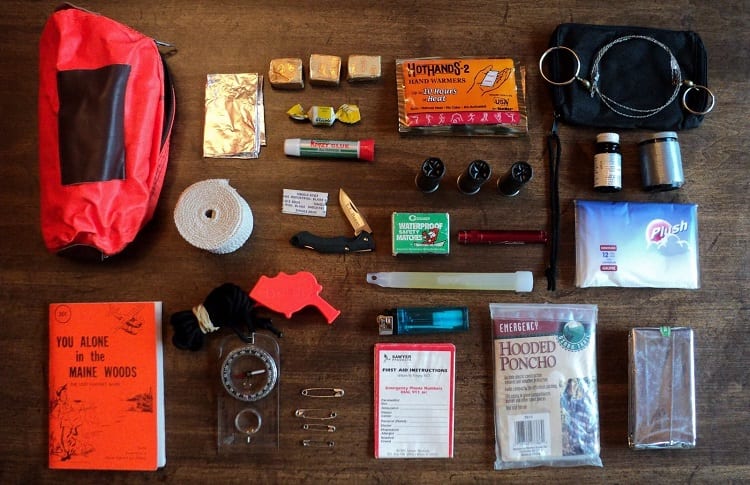
We used to try and find the best 72 hour survival kit out there, but over the years, manufacturers have stepped up quality (and what they contain). This is what you need in a survival kit to last you for three days up to three months.
- Survival Knife: A sharp steel knife (preferably with a carbon edge) to clean fish, cut bandages and cloth, provide self-defense, and fletch to pass the time. You’ll find that your survival knife is something you rely on time and time again, and for more than just bashing tent stakes into the ground.
- Emergency Blanket: We’re used to the ambient temperature of our homes, or the heightened warmth in a metropolitan area, so when we have to rough it in the wild we can face debilitating temperatures. An emergency blanket traps in 90%+ of your body heat to keep you warm through the night.
- Compass: GPS systems can fail, or run out of batteries. You should have the know-how to navigate with a compass and a map should the need arise. A survival kit compass will serve for basic navigation purposes, as opposed to a lensatic compass.
- Paracord: Paracord is often stored in bracelets. This super durable rope-like material can be used to make a pulley system over a tree branch, secure a tarp to a natural cover, and tons of other uses. In fact, there are at least eighty-five practical paracord uses that you may encounter during survival.
- Whistle: There’s no better way to signal your whereabouts to other members of your party than with a quality whistle. Many whistles can reach 120dB with some even going higher, so if you’re injured while scouting, other members of your party can locate you. For context, 120dB is the equivalent of attending an unhinged rock concert and standing in the third row without earplugs.
- Carabiner: The only issue with survival kits is that they don’t come with enough of these. Seriously, you’re going to find tons of uses for carabiners from securing tarp eyelets to branches, keeping your water bottle hanging from your backpack, keeping keys handy, and more.
- Multitool: This is a vague term, but a multitool could be the handle of a survival knife with a built-in screwdriver and bottle opener. It could be a card-sized steel rectangle that you keep in your wallet with notches for different uses. A sturdy multitool that can be used for more than a handful of tasks is invaluable, and weighs less than carrying separate dedicated tools.
- Wire Saw: Wire saws are excellent for building shelter. You can trim branches, create lean-tos and canopies, and gather wood for fletching your own DIY bow and arrows. You’ll find that these come in handy in the beginning of bugging out, and provide small uses all throughout your survival period.
- Tactical Flashlight: Tactical flashlights are perfect for low-lumen level power to light up your path ahead, but not give away your position. With some modes, you can signal for help using SOS flash signals, and a burst mode to temporarily blind assailants with a high output burst of light. Never underestimate a good flashlight.
- Screwdriver: Small repairs to survival gear should take a small amount of your time. You don’t have to dig through your backpack to find a dedicated miniature screwdriver kit (which would be a waste of your maximum carry weight anyway); instead you can flip out this portion of your multitool.
- Plier Tool: Anything that can provide you with leverage is a good thing. Plier tools, mini pry bars, and those card-sized multitools that we talked about earlier. You might not find yourself trimming electrical wires during survival, but the durable handles, built-in knives, tools and other add-ons will come in handy.
- Eating Utensils: While not a requirement, having an eating utensil lets you hold onto a feeling of normalcy like you’re still at home. It also helps you conserve small scraps of food, and dig every last morsel out of cans or jars.
- Tactical Pen: You can make markings on your map to designate where your camp is, write down coordinates and important information, and if you’re in trouble, it’s an unsuspecting self-defense weapon. Sometimes the pen really can be mightier than the sword.
Pre-made survival kits are usually stacked to the seams with inclusive gear, so while there isn’t room to include these other items, you should make sure they’re nearby.
- Emergency cell phone
- Charger/batteries
- Sanitary wipes
- Emergency radio or survival radio
- Belt cutter tool
- Local paper map
- Water sanitation tablets
Place your survival kit in a slightly larger bag with these additional items, essentially making your own survival kit with some pre-made elements.
What Should be in a Survival Kit?
The best survival kit should include tools that help you survive in the wilderness or adverse situations.
As you’ve seen from the list we just reviewed, you should have tools to provide leverage, be able to cut lumber to make shelter, sever cloth, clean fish, tend to small repairs, and aid in navigation.
Your survival kit should assist you in every situation that you see yourself facing. While no survival kit is 100% perfect, they’re compact, quick ways to get access to reliable tools to help you carry out your survival tasks.
Difference Between First Aid Survival Kits and Survival Kits?
The best compact survival kit should contain everything you need for niche situations.
However, they’re broken up into two categories: survival and first aid. First aid kits will include some items that survival kits include, but survival kits typically stick to tools and supplies only; nothing medical-related.
A first aid survival kit is designed to help you patch yourself up on-the-go to avoid infections, treat wounds, and assist in recovery from ailments.
A survival kit is designed to provide you with the necessary tools to manipulate your environment (namely nature), and bring you a mix of utility, visibility, and self-defense should you need it.
Most hybrid kits, which include a full amount of survival gear and first aid gear, end up missing the mark. It’s better to get one dedicated kit of each type.
There is also a chance that you’ll need multiple of the same kit depending on how long you’re roughing it in a SHTF climate. Typically, knives run dull and emergency blankets get used, so after three months of continuous use you’ll want to retire your first kit and open up another.
How Durable Are Survival Kits?
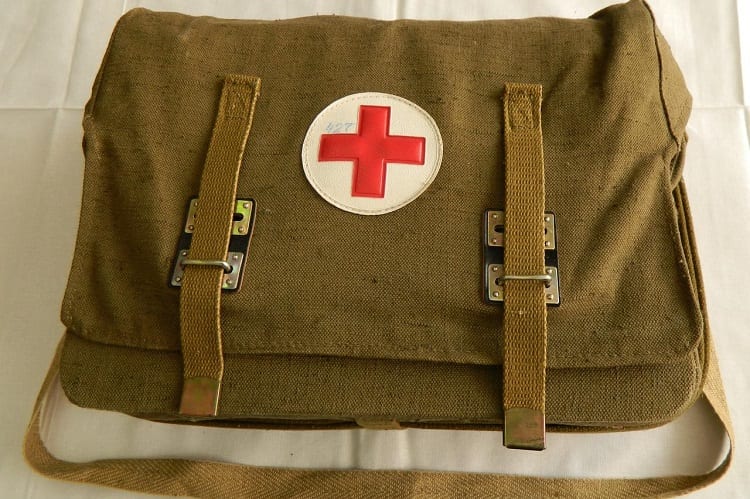
There are so many working parts that it’s hard to break this down. We’ll go component by component.
While these survival kits get the job done, if you have the time and money, you may consider piecing together your own kit. Keep in mind, it will be 10-15x more expensive than buying an all-in-one kit, but here we go.
Case Durability
Cases are typically made out of nylon, but you might also run into some really cheap plastics that don’t hold up for even the fist half-a-dozen kit uses.
You’ll even see peppered through these reviews that I mentioned some cases are just good for getting the survival kit items to your door, and at that point they should be replaced.
You want a touch, 800D+ nylon case that can withstand pokes, abrasions, and sharp edges from your tools without giving out.
Survival Knife
This is something that comes down to personal preference. You’re not going to be using this knife for everything you do, which is why they’re made with as much quality as is acceptable for a kit like this.
That being said, they’re not as good as a brand new Gerber 06 Fast, but they get the job done. If you like a little more reliability in your knife, you may consider switching it out.
Compass
For a survival kit that you include in your bug out bag or in your car, the compass included is fine for finding true north.
However, if you’re talking about a real SHTF situation, you’ll be better off with a lensatic compass and paper maps.
Fishing Gear
Look, those fishing hooks and the line that are included with a lot of survival kits are nice, but they don’t hold up against an actual fishing kit (and I’m not talking about an expensive one either).
You can pack your own fishing kit without taking up more than a tenth an ounce of space over the pieces included in your survival kit, and it will do you better. You’ll notice from the reviews above that the fishing hooks usually don’t hold up well.
Overall Sustainability
You’re getting a middle-of-the-road product in each category. Grouping them together like this and packaging them as an item saves the manufacturer money, which is why we get the lowest prices possible.
These kits provide the best durability out of any survival kits out of this price range, but they still may not compare to higher-priced individual items.
Should You Have More Than One Survival Kit?
Yes, absolutely. At the very least, you need one survival kit for utility (knife, multitool, etc.), and one survival kit that is specifically designated for first aid.
We have no idea what’s going to happen when SHTF, which means we need to have as many contingency plans in place as possible. The hospitals may not be available, or they may not be safe enough to travel to.
For these inexpensive all-in-one survival kits, you’re going to end up with just about all you need for niche situations. It’s recommended to have a survival kit in your camping/bug out gear, one in your home, and one in your car.
That way you’ll be prepared for situations that arise when we least expect them. Chances are you’re in your home or near your car when something goes amiss. If you regularly commute on public transportation, consider keeping a legal survival kit in your EDC gear.
A Prepared Survivalist is a Smart Survivalist
Whether it’s preparing for self-defense scenarios, having the tools to live off the land, or being prepared to treat any wound short of fiel surgery, it’s paramount that you enter a SHTF situation as prepared as possible.
A survival kit will only do so much of the work for you; it’s also important to learn how to use them.
You should be continuously sharpening and honing your skills.
It’s worth checking ou the First Aid Certification Program offered by Red Cross to truly learn how to use everything in a first aid kit, and why it’s important. Get the necessary training to ensure that you can handle what it takes to perform first aid in SHTF situations.





